Crested Tern call. 108kb
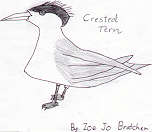
Illustrations by students from Richmond Primary School
Water Birds |
Parrots |
Other Birds
Play the
Crested Tern call. 108kb
Sterna bergii 430 - 480 mm (17")
Similar to Silver Gull but with black cap with short crest at back of head. Wings dark grey, with white underbody and neck.Inhabits all coastal and continental shelf areas. Its natural food mainly small fish and other marine life but it will scavenge waste food and offal. Not likely to nest on the island but a regular visitor.
Illustration by Zoe Jo Bratchen
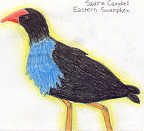
Porphyrio melanotus = Porphyrio porphyrio
Height 500mm (20") Medium large black water bird with blue underparts and white under tail.
Common throughout Australia, the eastern swamphen lives on the reed beds around the island feeding on grass, aquatic plants and small freshwater animals. It builds a nest of reeds and other plant material built on broken down reeds. Lays up to seven eggs in season (between August and December.
Illustration by Sadira Campbell
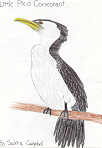
Phalacrocorax melanoleucos
Height 580mm (23") Large bird, black and white breast.
Common throughout Australia. Commonly seen fishing in the river where, because its feathers are not waterproof, it swims low in the water. Regularly seen drying its feathers on the jetties and trees overhanging the river around the island. Lives on aquatic life. Builds a flattish nest of sticks and small green twigs, placed on a branch of a tree. Lays between four and seven eggs in a breeding season from September to January.
Illustration by Sadira Campbell
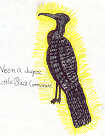
Phalacrocorax sulcirostris
Height 630 mm (25")
Large black bird with a yellow patch around the bill and eye. Common throughout Australia and around the island. Characteristics are similar to the Little Pied Cormorant.
Illustration by Vesna Jugovic
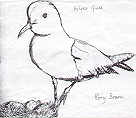
Larus novaehollandiae
Height 390 mm (15") Very common throughout Australia and throughout waterways and coastal areas of Melbourne.
Long legged grey and white bird. Its natural food mainly small fish and other marine life but it will scavenge waste food and offal.
Not likely to nest on the island but a regular visitor. Lays up to five eggs which vary considerably in the ground-colour and distribution of markings in a breeding season from May to February.
Illustration by Rory Brown

Gallinula tenebrosa
Height 380mm (15") Distributed throughout eastern Australia, and south-western Australia; also in New Guinea.
Medium large dark bird with white under tail and a red-orange bill. Seen in the reed beds around the island feeding on aquatic plants, and insects.
Lays five to seven eggs in an open nest made of reed-stems and dried grasses built on a platform of broken-down tussock between August and December.
Illustration by Vesna Jugovic
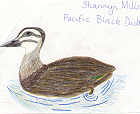
Anas superciliosa
Height 560 mm (22")
Large brownish duck with white lines above and below eye, white on throat and under wing, with a green wing patch.
Moderately common throughout Australia.
Seen around the island living on grass, herbage, aquatic plants and animals.
Lays eight to fourteen eggs during a breeding season from July to December. Makes an open nest of dried grass and lined with feathers; often placed on the ground among rushes or grass growing near water .
Illustration by Shannyn Mills
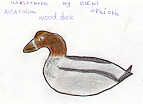
Chenonetta jubata
Height ?
Distributed throughout most of the mainland and Tasmania. Commonly seen grazing on the island or on the nearby river banks near Como Landing.
Lays six to twelve eggs in a nest located in a hole in a tree, lined with feathers and down; often high up, and sometimes far from water. Breeding season: all the year, dependent on rainfall.
Illustration by Eleni Spiliotis
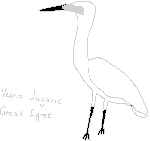
Egretta alba
Height 90-100cm (34" - 40")
Very large white, long legged fresh water bird. Distributed throughout Australia where suitable habitat is found; also occurs in many other countries.
Singly, in pairs or in small groups, frequenting swamps or margins of lakes and streams. It is nomadic and rather rare. Feeds on aquatic animals.
Lays four, pale bluish-green eggs, (the surface being minutely pitted) in a nest made of a platform of sticks, placed in the branches of a tree growing in or at the edge of water; breeds in colonies, often in association with other wading birds.
. Breeding season: November to January.
Illustration by Vesna Jugovic

Egretta garzetta
Height 60cm (24")
White, long legged fresh water bird. Distributed in northern and eastern Australia, from Exmouth Gulf(W.A.) to western Victoria, occasionally to South Australia; very rarely to Tasmania; also occurs in many other countries. Not recorded in the 1990 fauna survey of Herring Island.
Singly, in pairs or in small flocks, frequenting swamps or margins of lakes and streams. It is nomadic and rather rare. Feeds on aquatic animals.
Lays three to five, pale bluish-green eggs, the surface being slightly glossy and minutely pitted in a nest made of a platform of sticks, placed in the branches of a tree growing in or at the edge of water; breeds in colonies, often in association with other wading birds.
Breeding season: October to December or January, sometimes later.
Illustration by Shannyn Mills
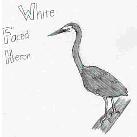
Ardea novahollandiae
610 mm (24")
Large, long legged and long necked grey bird and white face. Common in Australia generally.
Usually seen wading in shallow water around the isalnd or perched on a dead limb of a tree near water. Lives on small freshwater animals and insects.
Lays three to six eggs on a flattish nest made from sticks, placed in the branches of a tree sometimes well away from water.
Breeding season: September to January.
Illustration by Fred Webber

Ardea novahollandiae
590 mm (23")
Moderately rare throughout most of Australia.
In pairs or flocks, frequenting margins of streams and swamps. It is a nocturnal feeder, but may be seen during the day roosting among bushy limbs of trees growing in or near water. It utters a harsh croaking note. Feeds on yabbies, freshwater molluscs, frogs and aquatic insects.
Lays three to six eggs on a scanty platform of sticks, placed in a horizontal branch of a tree sometimes well away from water.
Breeding season: September to January.
Illustration by Richard Lau
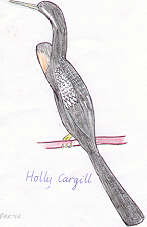
Anhinga melanogaster
Also called Snake-bird, Diver or Shag.
Singly or in pairs, in inland lakes or waterways throughout mainland Australia. If disturbed when swimming, will submerge its body leaving only the head and neck above water, thus the name snake-bird. Feeds on fish and aquatic animals.
Builds a substantial platform of twigs and sticks, in a low tree either overhanging or in water. Lays 3 - 5 greenish eggs covered in whitish lime, when conditions are suitable.
Illustration by Holly Cargill
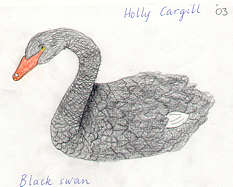
Cygnys atratus
1000 - 1500 mm (40 - 60")
Very large black bird with long slender neck and white tipped wings, red bill, with black legs and feet. Frequents lakes, rivers and swamps, feeding on aquatic plants and animals. Has a musical trumpeting call.
Builds a large open, thick walled nest of twigs, rushess and aquatic vegetation, in swamps and lakes. Lays 5 - 6 pale green or dull green eggsin a breeding season of autumn and winter, but sometimes as late as December.
Illustration by Holly Cargill

Text by Stanley Barker sourced from "What Bird is That? A Guide to the Birds of Australia" by Neville Cayley; Published by Angus & Robertson 1973
and the "Birds of ..." series by the Gould League.
Artwork by students of Richmond Primary School, Year 6, 1999, 2003
About Herring Island |
Getting to and What's on |
Island Map |
Artworks |
Plants |
Birds |
Sir Edmund Herring |
6 seasons |
Other Sculpture Parks
To join the Friends |
Annual Reports |
Planting Days |
Our other Friends